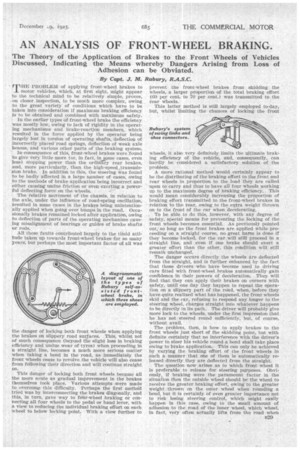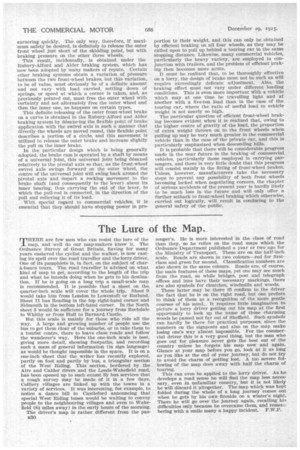AN ANALYSIS OF FRONT-WHEEL BRAKING.
Page 13

Page 14

If you've noticed an error in this article please click here to report it so we can fix it.
The Theory of the Application of Brakes to the Front Wheels of Vehicles Discussed, Indicating the Means whereby Dangers Arising from Loss of Adhesion can be Obviated.
By Capt. J. M. Rubury, R.A.S.C.
THE PROBLEM of applying front-wheel brakes to motor vehicles, which, at first sight, might appear to the technical mind to be relatively simple, proves, on closer inspection, to be much more complex, owing to the great variety of conditions which have to be taken into consideration if maximum braking efficiency is to be ,obtained and combined with maximum safety.
In the earlier types Of front-wheel brake the efficiency was mostly low, owing to lack of rigidity in the operating mechanisms and brake-reaction members, which resulted in the force applied by the operator being largely lost in torsion of operating shafts, deflection of incorrectly placed road springs, deflection of weak axle beams, and various other parts of the braking system.
• In consequence of this, front-wheel brakes were found to give Very little more (or, in fact, in_soine cases, even less) stopping power than the ordinMy rear brakes, and, more particularly, than the high-speed transmission brake. In addition to this, the steering Was found to be badly affected in a large n.umber of cases, owing to the methods of brake application being incorrect and either causing undue friction or even exerting a powerful deflecting force on the wheels.
The relative movement of the chassis, in relation to the axle, under the influence of road-spring oscillation, resulted in some cases in the brakes being unintentionally applied when going over bumps in the road. Occasionally brakes remained locked after application, owing to deflection of parts of the operating mechanism causing misalignment of bearings or guides of brake shafts or rods.
All these faults contributed largely to the timid attitude taken up towards front-wheel brakes for so many years, but perhaps the most important factor of all was
the danger of locking both front wheels when applying the brakes on slippery road surfaces. This, whilst not of much consequence (beyond the slight loss in braking efficiency and undue wear of tyres) when proceeding. in a straight line, becomes a much more serious matter when taking a bend in the road, as immediately the front wheels cease to revolve the vehicle will also cease from following-their direction and will continue straight on.
This danger of locking both front wheels became all the more acute as gradual improvement in the brakes themselves took place. Various attempts were made to overcome this difficulty. Perhaps the first methdd tried was by interconnecting the brakes diagonally, and this, in turn, gave way to four-wheel braking or connecting all four wheels to the pedal or hand lever, with a view to reducing the individual braking effort on each wheel to below locking point. With a view further to
prevent the front-wheel brakes from skidding the wheels, a larger proportion of the total braking effort (60 per cent. to 70 per cent.) was transmitted to the rear wheels.
. This latter method is still largely employed to-day, but, whilst limiting the chances of locking the front wheels, it also very definitely limits the ultimate braking efficiency of the vehicle, and, consequently, can hardly be considered a satisfactory solution of the problem.
A more rational method would certainly appear to be the distributing of the braking effort to the front and rear wheels in proportion to the load they are called upon to carry and thus to have all four wheels working. up to the maximum degree of braking efficiency. This would mean considerably increasing the proportion of braking effort. transmitted to the front-wheel brakes in relation to the rear, owing to the extra weight thrown On to the front of the car when decelerating.
.To be able to do this, however, with any degree of Safety, special means for preventing the locking of the front wheels becomes essential. As previously pointed out; so long as•the front brakes are applied while proceeding on a straight course, no great harm is done if they become locked, for the ear will still proceed in a. straight line, and even if one brake should exert a greater effort than the other, this condition will still remain unchanged.
The danger occurs directly the wheels are deflected from the straight, and is further enhanced by the fact that those drivers who have become used to driving cars fitted with front-wheel brakes automatically gain confidence in their powers of deceleration. They will find that they can apply their brakes on corners with safety, until one day they happen to repeat the operation on a slippery part of the road, when, before they have quite realized what has happened, the front wheelS skid and the car, refusing to respond any longer to the steering wheel, charges straight into whatever happens to be directly in its path. The driver will probably give more leek to the wheels, under the first impression that he has not steered round sufficiently, but, of course, without avail.
The problem, then, is how to apply brakes to the front wheels just short of the skidding point, but with de.finite certainty that no interference with the driver's power to steer his vehicle round a bend shall take place owing to brake application. This can only be achieved by varying the braking effort of the front wheels in such a manner that one of them is automatically released directly they are deflected from the straight.
The question now arises as to which front wheel it is preferable to release for steering purposes. Obviously, if braking were the paramount factor in the situation then the outside wheel should be the wheel to receive the greater braking effort, owing to the greater weight :thrown on the outer wheel when rounding a bend, but it is certainly of even greater importance not to risk Josing steering control, which might easily happen in this case, owing to . the small amount of adhesion to the road of the inner wheel, which wheel, in fact, very often actually lifts from the road when cornering quickly. The only way, therefore, if maximum safety be desired, is definitely to release the outer front wheel just short of the skidding point, but with braking pressure on the other three wheels.
This result, incidentally, is obtained under the Rubury-Alford and Alder braking system, which has now been adopted by many makers of repute. Certain other braking systems obtain a variation of pressure between the two front-wheel brakes, but this variation, to be of value, must obviously be of a definite amount and not vary with load carried, settling down of springs, or speed at which a corner is taken, and, as previously pointed out, must free the outer wheel with certainty and not alternately free the outer wheel and then the inner one, as happens on certain types.
This definite releasing of the outer front-wheel brake on a curie is obtained in the Rubury-Alford and Alder braking system by d&axe-ing the flexible point of brake application with the swivel axis in such a manner that directly the wheels are moved round, this flexible point describes a portion of a circle, and this movement is utilized to release the outer brake and increase slightly the pull on the inner brake.
In the particular design which is being generally adopted, the brake cam is operated by a shaft by means of a universal joint, this universal joint being &sexed relatively to the pivotal axis so that, as the front-wheel swivel axle swings forward on the outer wheel, the centre of the universal joint will swing back around the pivotal axis and impart a rocking movement to the brake shaft (and consequently to the lever) about its inner bearing, thus carrying the end of the lever, to which the pull-rod is connected, in the direction of the pull and relieving it of its load.
With special regard to commercial vehicles, it is essential that they should have stopping power in pro
portion to their weight, and this can only be obtained by efficient braking on all four wheels, as they may be called upon to pull up behind a touring car, in the same storming distance. Likewise, many commercial vehicles, particularly the heavy variety, are employed in conjunction with trailers, and the problem of efficient braking then becomes more acute. It must be realized that, to be thoroughly effective on a lorry, the design of brake must not be such as will require exceedingly delicate adjustment. Also, the braking effect must not vary under different loading conditions. This is even more important with a vehicle which may at one time be travelling light and at another with a five-ton load than in the case of the touring car, where the ratio of useful load to vehicle weight is not nearly so high.
The particular question of efficient front-wheel braking becomes evident when it is realized that, owing to the higher centre of gravity of the load, the proportion of extra weight thrown on to the front wheels when pulling up may be very much greater in the commercial vehicle than in the case of the private car, and this is particularly emphasized when descending hills.
It is probable that there will be considerable progress made in the near future in the braking of commercial vehicles, particularly those employed in carrying passengers, and there is very little doubt that this progress will consist mainly in the fitting of front-wheel brakes. Unless, however, manufacturers take the necessary steps to prevent any possibility of both front wheels becoming loeked when negotiating corners, the chapter of serious accidents of the present year is hardly likely to be much less in the future and will only offer a further setback to front-wheel braking which otherwise, carried out logically, will result in conducing to the general safety of the public.






























